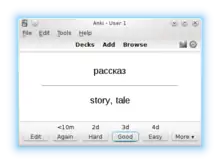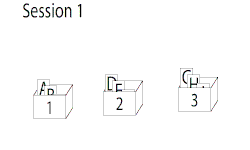Spaced repetition
Spaced repetition is an evidence-based learning technique that is usually performed with flashcards. Newly introduced and more difficult flashcards are shown more frequently, while older and less difficult flashcards are shown less frequently in order to exploit the psychological spacing effect. The use of spaced repetition has been proven to increase the rate of learning.[1]

Although the principle is useful in many contexts, spaced repetition is commonly applied in contexts in which a learner must acquire many items and retain them indefinitely in memory. It is, therefore, well suited for the problem of vocabulary acquisition in the course of second-language learning. A number of spaced repetition software programs have been developed to aid the learning process. It is also possible to perform spaced repetition with flashcards using the Leitner system.
Alternative names for spaced repetition include spaced rehearsal, expanding rehearsal, graduated intervals, repetition spacing, repetition scheduling, spaced retrieval, and expanded retrieval.
History
Over the years, techniques and tests have been formed to better patients with memory difficulties. Spaced repetition is one of these solutions to help better the patients' minds. Spaced repetition is used in many different areas of memory from remembering facts to remembering how to ride a bike to remembering past events from childhood.[2] Recovery practice is used to see if an individual is able to recall something immediately after they have seen or studied it. Increasing recovery practice is frequently used as a technique in improving long-term memory, essentially for young children trying to learn and older individuals with memory diseases.[3]
The basis for spaced repetition research was laid by Hermann Ebbinghaus, who suggested that information loss over time follows a forgetting curve, but that forgetting could be reset with repetition based on active recall.
The spaced repetition training was first tested by Landauer and Bjork in 1978; they gathered a group of psychology students showing the students pictures of a certain individual followed by that individual's name. This is also known as a face-name association. With the repetition of seeing the person's name and face they were able to associate the name and face of that individual shown with the expansion of time due to the spaced repetition.[2]
Schacter, Rich, and Stampp in 1985 furthered the research to include people who have amnesia and other memory disorders. The findings showed that using spaced repetition can not only help students with name face association but individuals dealing with memory impairments.[4]
In 1989, C. J. Camp decided that using this technique with Alzheimer's patients may increase their duration of remembering particular things.[2] These results show that the expansion of the time interval shows the strongest benefits for memory.[4]
Spaced repetition is a method where the subject is asked to remember a certain fact with the time intervals increasing each time the fact is presented or said. If the subject is able to recall the information correctly the time is doubled to further help them keep the information fresh in their mind to recall in the future. With this method, the patient is able to place the information in their long-term memory. If they are unable to remember the information they go back to the previous step and continue to practice to help make the technique lasting (Vance & Farr, 2007).
The expansion is done to ensure a high success level of recalling the information on the first time and increasing the time interval to make the information long-lasting to help keep the information always accessible in their mind.[3] Throughout the development of spaced repetition, they have found that patients using this technique with dementia are able to recall the information weeks—even months—later. The technique has been successful in helping dementia patients remember particular objects' names, daily tasks, name face association, information about themselves, and many other facts and behaviors (Small, 2012). Sufficient test evidence shows that spaced repetition is valuable in learning new information and recalling information from the past.[4]
Small combines the works and findings of quite a few scientists to come up with five reasons why spaced repetition works: it helps show the relationship of routine memories, it shows the benefits of learning things with an expansion of time, it helps the patient with Alzheimer's dementia keep their brain active, it has a high success level with little to no errors, and the technique is meaningful for the patient to do and remember more things (Small, 2012). Joltin et al. (2003), had a caregiver train a woman with Alzheimer's by giving her the name of her grandchild over the phone while asking her to associate with the picture of the grandchild posted on the refrigerator. After training, the woman was able to recall the name of her grandchild five days later.[4]
Research and application
The notion that spaced repetition could be used for improving learning was first proposed in the book Psychology of Study by Prof. C. A. Mace in 1932: "Perhaps the most important discoveries are those which relate to the appropriate distribution of the periods of study... Acts of revision should be spaced in gradually increasing intervals, roughly intervals of one day, two days, four days, eight days, and so on."[5]
In 1939, H. F. Spitzer tested the effects of a type of spaced repetition on sixth-grade students in Iowa who were learning science facts.[6] Spitzer tested over 3600 students in Iowa and showed that spaced repetition was effective. This early work went unnoticed, and the field was relatively quiet until the late 1960s when cognitive psychologists, including Melton[7] and Landauer and Bjork,[8] explored manipulation of repetition timing as a means to improve recall. Around the same time, Pimsleur language courses pioneered the practical application of spaced repetition theory to language learning, and in 1973 Sebastian Leitner devised his "Leitner system", an all-purpose spaced repetition learning system based on flashcards.
With the increase in access to personal computers in the 1980s, spaced repetition began to be implemented with computer-assisted language learning software-based solutions (see § Software), enabling automated scheduling and statistic gathering, scaling to thousands of cards scheduled individually. To enable the user to reach a target level of achievement (e.g. 90% of all material correctly recalled at any given time point), the software adjusts the repetition spacing interval. Material that is hard appears more often and material that is easy less often, with difficulty defined according to the ease with which the user is able to produce a correct response.
The data behind this initial research indicated that an increasing space between rehearsals (expanding) would yield a greater percentage of accuracy at test points.[9] Spaced repetition with expanding intervals is believed to be so effective because with each expanded interval of repetition it becomes more difficult to retrieve the information because of the time elapsed between test periods; this creates a deeper level of processing of the learned information in long-term memory at each point. Another reason that the expanding repetition model is believed to work so effectively is that the first test happens early on in the rehearsal process.[10] The purpose of this is to increase repetition success. By having a first test that followed initial learning with a successful repetition, people are more likely to remember this successful repetition on the following tests.[11] Although expanding retrieval is commonly associated with spaced repetition, a uniform retrieval schedule is also a form of spaced repetition procedure.[10]
Spaced repetition is typically studied through the use of memorizing facts. Traditionally speaking, it has not been applied to fields that required some manipulation or thought beyond simple factual/semantic information. A more recent study has shown that spaced repetition can benefit tasks such as solving math problems. In a study conducted by Pashler, Rohrer, Cepeda, and Carpenter,[12] participants had to learn a simple math principle in either a spaced or massed retrieval schedule. The participants given the spaced repetition learning tasks showed higher scores on a final test distributed after their final practice session.[12]
This is unique in the sense that it shows spaced repetition can be used to not only remember simple facts or contextual data but it can also be used in fields, such as math, where manipulation and the use of particular principles or formulas (e.g. y = mx + b) is necessary. These researchers also found that it is beneficial for feedback to be applied when administering the tests. When a participant gave a wrong response, they were likely to get it correct on the following tests if the researcher gave them the correct answer after a delayed period. Spaced repetition is a useful tool for learning that is relevant to many domains such as fact learning or mathematics, and many different tasks (expanding or uniform retrieval).[12] Many studies over the years have contributed to the use and implementation of spaced repetition, and it still remains a subject of interest for many researchers.[13]
Algorithms
There are several families of algorithms for scheduling spaced repetition:
- Neural network based[14]
- Leitner system: 5 levels and an arbitrary number of stages
- SM-family of algorithms (SuperMemo): SM-0 (a paper implementation) to SM-18 (in SuperMemo 18)
Some have theorized that the precise length of intervals does not have a great impact on algorithm effectiveness,[15] although it has been suggested by others that the interval (expanded interval vs. fixed interval, etc.) is quite important. The experimental results regarding this point are mixed.[16]
Implementations
Software

Most spaced repetition software (SRS) is modeled after the manual style of learning with physical flashcards: items to memorize are entered into the program as question-answer pairs. When a pair is due to be reviewed, the question is displayed on a screen, and the user must attempt to answer. After answering, the user manually reveals the answer and then tells the program (subjectively) how difficult answering was. The program schedules pairs based on spaced repetition algorithms. Without a computer program, the user has to schedule physical flashcards; this is time-intensive and limits users to simple algorithms like the Leitner system.[17]
Further refinements with regard to software:
- Questions and/or answers can be a sound file to train recognition of spoken words.
- Automatic generation of pairs (e.g. for vocabulary, it is useful to generate three question-pairs: written foreign word, its pronunciation and its meaning, but data only has to be entered once.)
- Additional information retrieved automatically is available, such as example sentences containing a word.
- Opportunities to combine spaced repetition with online community functions, e.g. sharing courses.
Flash cards

The Leitner system is a widely used method of efficiently using flashcards that was proposed by the German science journalist Sebastian Leitner in the 1970s. It is a simple implementation of the principle of spaced repetition, where cards are reviewed at increasing intervals.
In this method, flashcards are sorted into groups according to how well the learner knows each one in Leitner's learning box. The learners try to recall the solution written on a flashcard. If they succeed, they send the card to the next group. If they fail, they send it back to the first group. Each succeeding group has a longer period of time before the learner is required to revisit the cards. In Leitner's original method, published in his book So lernt man Lernen (How To Learn To Learn), the schedule of repetition was governed by the size of the partitions in the learning box. These were 1, 2, 5, 8 and 14 cm. Only when a partition became full was the learner to review some of the cards it contained, moving them forward or back, depending on whether they remembered them.
Audio instruction
Graduated-interval recall is a type of spaced repetition published by Paul Pimsleur in 1967.[18] It is used in the Pimsleur language learning system and is particularly suited to programmed audio instruction due to the very short times (measured in seconds or minutes) between the first few repetitions, as compared to other forms of spaced repetition which may not require such precise timings. The intervals published in Pimsleur's paper were: 5 seconds, 25 seconds, 2 minutes, 10 minutes, 1 hour, 5 hours, 1 day, 5 days, 25 days, 4 months, and 2 years.
Criticism
Spaced repetition with expanding intervals has long been argued to be the most beneficial version of this learning procedure, but current research, which compared repetition procedures, has shown the difference between expanding repetition and uniform retrieval is either very little to nonexistent. Some researchers have found cases where uniform retrieval is better than expanding. The main speculation for this range of results is that prior research has not accounted for the possibility of their results being affected by either the spacing condition or the number of successful repetitions during study periods.[10]
There are two forms of implementing spacing in spaced repetition. The first form is absolute spacing. Absolute spacing is the measurement of all the trials within the learning and testing periods. An example of this would be that participants would study for a total of thirty trial periods, but the spacing of these trials can either be expanding or uniform. The second form is called relative spacing. Relative spacing measures the spacing of trials between each test. An example of this would be if the absolute spacing was thirty, participants would either have expanding intervals (1–5–10–14) or uniform intervals (5–5–5–5–5–5). This is important in measuring whether or not one type of repetition schedule is more beneficial than the other.[10]
A common criticism of repetition research has argued that many of the tests involved have simply measured retention on a short-term scale. A study conducted by Karpicke and Bauernschmidt[10] used this principle to determine the major differences between the different types of repetition. The two focused on studying long-term retention by testing participants over the course of one week. The participants were either assigned to a uniform schedule or an expanding schedule. No matter what type of spacing was assigned to the ninety-six participants, each completed three repeated tests at the end of their rehearsal intervals. Once those tests were completed, participants came back one week later to complete a final retention test. The researchers concluded that it did not matter what kind of repetition schedule was used. The biggest contribution to effective long-term learning was the spacing between the repeated tests (absolute spacing).[10]
References
- Smolen, Paul; Zhang, Yili; Byrne, John H. (January 25, 2016). "The right time to learn: mechanisms and optimization of spaced learning". Nature Reviews Neuroscience. 17 (2): 77–88. arXiv:1606.08370. Bibcode:2016arXiv160608370S. doi:10.1038/nrn.2015.18. PMC 5126970. PMID 26806627.
- Oren, Shiri; Willerton, Charlene; Small, Jeff (February 2014). "Effects of Spaced Retrieval Training on Semantic Memory in Alzheimer's Disease: A Systematic Review". Journal of Speech, Language, and Hearing Research. 57 (1): 247–270. doi:10.1044/1092-4388(2013/12-0352). ISSN 1092-4388. PMID 24023380.
- Karpicke, J. D., & Roediger, H. (2007). Expanding repetition practice promotes short-term retention, but equally spaced repetition enhances long-term retention. Journal of Experimental Psychology: Learning, Memory, and Cognition, 33(4), 704–719. doi:10.1037/0278-7393.33.4.704.
- Hawley, K. S., Cherry, K. E., Boudreaux, E. O., & Jackson, E. M. (2008). A comparison of adjusted spaced repetition versus a uniform expanded repetition schedule for learning a name-face association in older adults with probable Alzheimer's disease. Journal of Clinical & Experimental Neuropsychology, 30(6), 639–649. doi:10.1080/13803390701595495.
- Mace, C. A. (1932). Psychology of Study. p. 39.
- Spitzer, H. F. (1939). "Studies in retention". Journal of Educational Psychology. 30 (9): 641–657. doi:10.1037/h0063404.
- Melton, A. W. (1970). "The situation with respect to the spacing of repetitions and memory". Journal of Verbal Learning and Verbal Behavior. 9 (5): 596–606. doi:10.1016/S0022-5371(70)80107-4. hdl:2027.42/32694.
- Landauer, T. K.; Bjork, R. A. (1978). "Optimum rehearsal patterns and name learning". In Gruneberg, M.; Morris, P. E.; Sykes, R. N. (eds.). Practical aspects of memory. Academic Press. pp. 625–632. ISBN 0123050502.
- Landauer, T., & Bjork, R. (1978). Optimum rehearsal patterns and name learning. Practical Aspects of Memory, 625–632. Retrieved October 15, 2014.
"Archived copy" (PDF). Archived from the original (PDF) on February 11, 2015. Retrieved December 10, 2014.
{{cite web}}: CS1 maint: archived copy as title (link) - Karpicke, Jeffrey D.; Bauernschmidt, Althea (2011). "Spaced retrieval: absolute spacing enhances learning regardless of relative spacing". Journal of Experimental Psychology: Learning, Memory, and Cognition. 37 (5): 1250–1257. doi:10.1037/a0023436. PMID 21574747. S2CID 16580641.
- Karpicke, J., & Roediger, H. (2010). Is expanding retrieval a superior method for learning text materials? Memory & Cognition, 38(1), 116–124. doi:10.3758/MC.38.1.116.
- Pashler, H., Rohrer, D., Cepeda, N., & Carpenter, S. (2007). Enhancing learning and retarding forgetting: Choices and consequences. Psychonomic Bulletin & Review, 14(2), 187–193.
- Brush, J., & Camp, C. (2008). Using Spaced Retrieval as an Intervention During Speech-Language Therapy. Clinical Gerontologist, 19(1), 51–64.
- "Implementing a neural network for repetition spacing". www.supermemo.com. Retrieved July 15, 2017.
- Cull, W. L. (2000). "Untangling the benefits of multiple study opportunities and repeated testing for cued recall". Applied Cognitive Psychology. 14 (3): 215–235. doi:10.1002/(SICI)1099-0720(200005/06)14:3<215::AID-ACP640>3.0.CO;2-1.
- Balota, David A.; Duchek, Janet M.; Logan, Jessica M. (2011). "6. Is Expanded Retrieval Practice a Superior Form of Spaced Retrieval? A Critical Review of the Extant Literature" (PDF). In Nairne, James S. (ed.). The Foundations of Remembering: Essays in Honor of Henry L. Roediger, III. Psychology Press. pp. 83–106. ISBN 978-1-136-87221-1.
- Gupta, James (January 23, 2016). "Spaced repetition: a hack to make your brain store information". The Guardian. ISSN 0261-3077. Retrieved January 30, 2019.
- Pimsleur, Paul (February 1967). "A Memory Schedule". The Modern Language Journal. Blackwell Publishing. 51 (2): 73–75. doi:10.2307/321812. JSTOR 321812.
Further reading
- Kail, R. V., & Cavanaugh J. C. (2007). "Spaced Retrieval". Human Development: A Life-Span View (5th ed.). Belmont, CA: Wadsworth.
- Wozniak, Piotr (February 1999). "Effective learning: Twenty rules of formulating knowledge".
{{cite web}}: CS1 maint: url-status (link) – advice on making flashcards for spaced repetition. - How to Memorize Faster With The Spaced Repetition Learning Technique